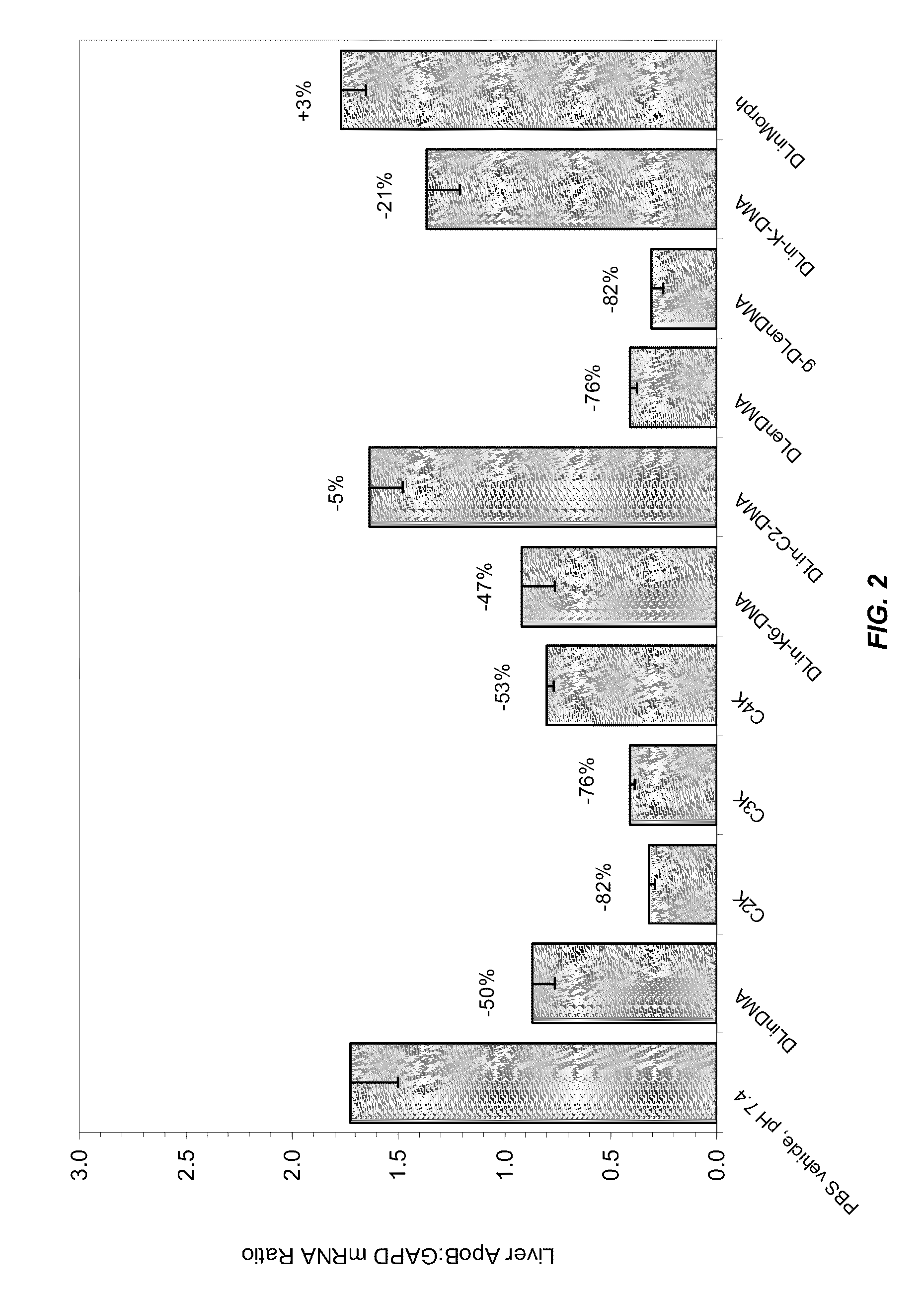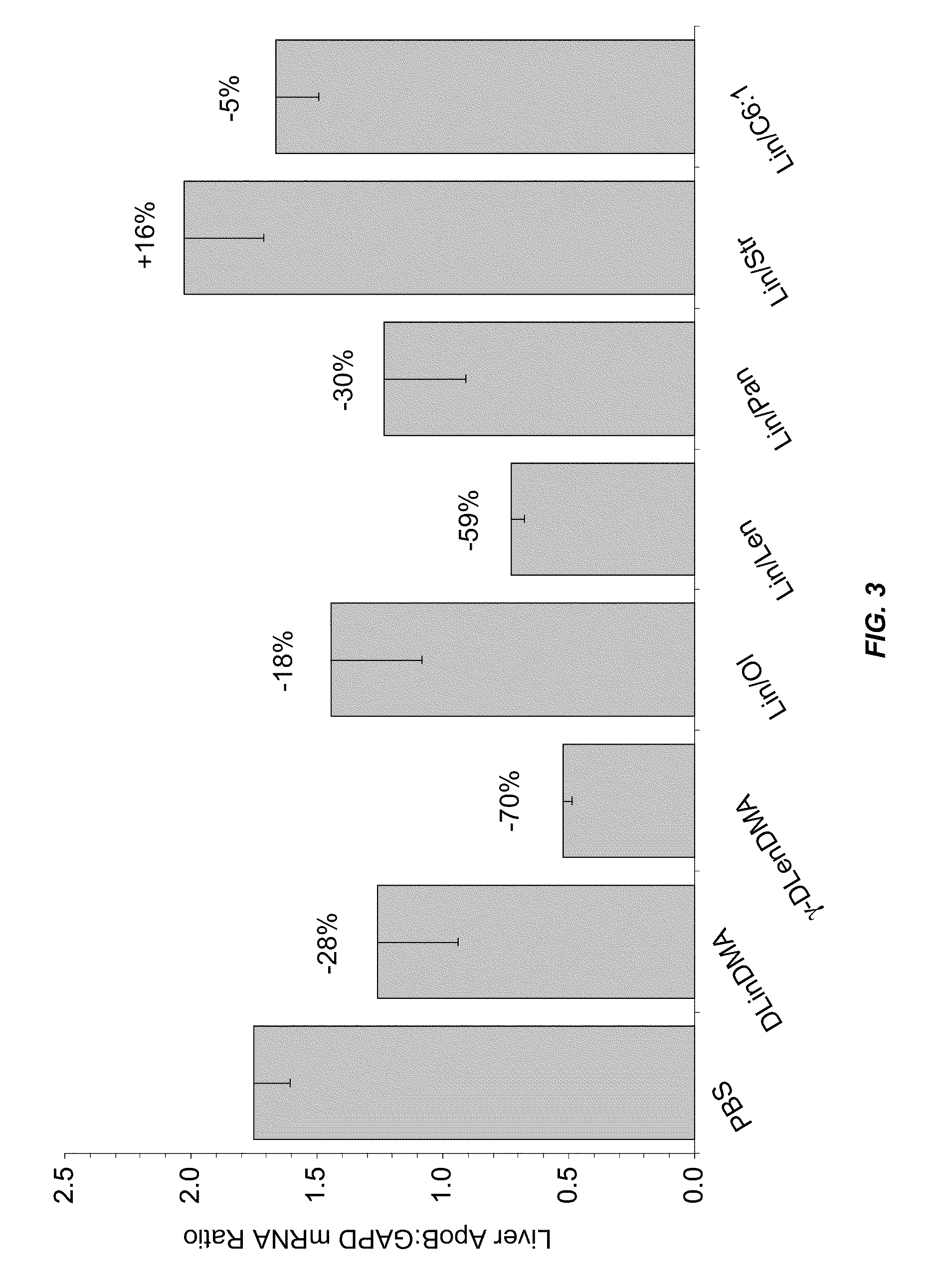Compositions and methods for silencing apolipoprotein b
a technology of apolipoprotein and silencing method, which is applied in the field of compositions and methods for silencing apolipoprotein b, can solve the problems of reducing the activity of the construct, reducing the susceptibility of the nuclease in plasma, and limited access to the intracellular compartment, so as to increase the silencing activity, increase the potency, and increase the tolerability
- Summary
- Abstract
- Description
- Claims
- Application Information
AI Technical Summary
Benefits of technology
Problems solved by technology
Method used
Image
Examples
example 1
Synthesis of 2,2-Dilinoleyl-4-Dimethylaminomethyl-[1,3]-dioxolane (DLin-K-DMA)
[0524]DLin-K-DMA was synthesized as shown in the schematic and described below.
Synthesis of Linoleyl Bromide (II)
[0525]A mixture of linoleyl methane sulfonate (6.2 g, 18 mmol) and magnesium bromide etherate (17 g, 55 mmol) in anhydrous ether (300 mL) was stirred under argon overnight (21 hours). The resulting suspension was poured into 300 mL of chilled water. Upon shaking, the organic phase was separated. The aqueous phase was extracted with ether (2×150 mL). The combined ether phase was washed with water (2×150 mL), brine (150 mL), and dried over anhydrous Na2SO4. The solvent was evaporated to afford 6.5 g of colourless oil. The crude product was purified by column chromatography on silica gel (230-400 mesh, 300 mL) and eluted with hexanes. This gave 6.2 g (approximately 100%) of linoleyl bromide (II). 1H NMR (400 MHz, CDCl3) δ: 5.27-5.45 (4H, m, 2×CH═CH), 3.42 (2H, t, CH2Br), 2.79 (2H, t, C═C—CH2—C═C), ...
example 2
Synthesis of 2,2-Dilinoleyl-4-(2-Dimethylaminoethyl)-[1,3]-dioxolane (DLin-K-C2-DMA)
[0531]DLin-K-C2-DMA was synthesized as shown in the schematic diagram and description below.
Synthesis of 2,2-Dilinoleyl-4-(2-hydroxyethyl)[1,3]-dioxolane (II)
[0532]A mixture of dilinoleyl ketone (I, previously prepared as described in Example 1, 527 mg, 1.0 mmol), 1,3,4-butanetriol (technical grade, ca. 90%, 236 mg, 2 mmol) and pyridinium p-toluenesulfonate (50 mg, 0.2 mmol) in 50 mL of toluene was refluxed under nitrogen overnight with a Dean-Stark tube to remove water. The resulting mixture was cooled to room temperature. The organic phase was washed with water (2×30 mL), brine (50 mL), and dried over anhydrous Na2SO4. Evaporation of the solvent resulted in a yellowish oily residual (0.6 g). The crude product was purified by column chromatography on silica gel (230-400 mesh, 100 mL) with dichloromethane as eluent. This afforded 0.5 g of pure II as colourless oil. 1H NMR (400 MHz, CDCl3) δ: 5.25-5.4...
example 3
Synthesis of 1,2-Di-γ-linolenyloxy-N,N-dimethylaminopropane (γ-DLenDMA)
[0535]γ-DLenDMA having the structure shown below was synthesized as described below.
[0536]A 250 mL round bottom flask was charged with 3-(dimethylamino)-1,2-propanediol (0.8 g, 6.7 mmol), tetrabutylammonium hydrogen sulphate (1 g), gamma linolenyl mesylate (cis-6,9,12-octadecatriene sulphonic acid) (5 g, 14.6 mmol), and 30 mL toluene. After stirring for 15 minutes, the reaction was cooled to 0-5° C. A solution of 40% sodium hydroxide (15 mL) was added slowly. The reaction was left to stir for approximately 48 hours. An additional 15 mL of toluene was then added to the reaction vessel, along with 40% sodium hydroxide (15 mL). After the reaction was stirred for an additional 12 hours, water (50 mL) and isopropyl acetate (50 mL) were added and stirred for 15 minutes. The mixture was then transferred to a 500 mL separatory funnel and allowed to separate. The lower aqueous phase was run off and the organic phase was w...
PUM
 Login to View More
Login to View More Abstract
Description
Claims
Application Information
 Login to View More
Login to View More - R&D
- Intellectual Property
- Life Sciences
- Materials
- Tech Scout
- Unparalleled Data Quality
- Higher Quality Content
- 60% Fewer Hallucinations
Browse by: Latest US Patents, China's latest patents, Technical Efficacy Thesaurus, Application Domain, Technology Topic, Popular Technical Reports.
© 2025 PatSnap. All rights reserved.Legal|Privacy policy|Modern Slavery Act Transparency Statement|Sitemap|About US| Contact US: help@patsnap.com



